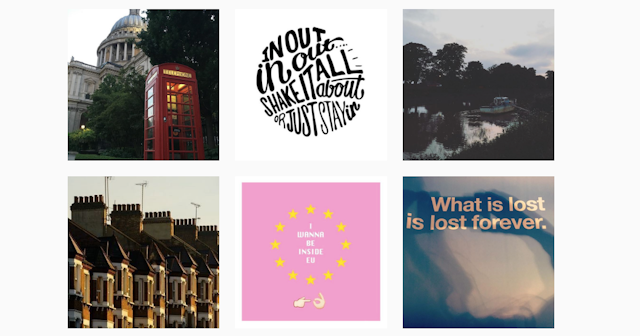Instagram is widely seen as the best social media site for bragging about your travels and your adventures in healthy eating – and is the home of the gloriously-filtered celebrity selfie. But it’s also where some of the most interesting EU referendum campaigning is playing out.
Instagram is the most popular social network for young people around the world. It allows users to upload and tag images of their everyday lives and share them with friends. Due to its close links to Facebook and its real name policy, it has become a much more polite and civil space for conversations than Twitter.
The focus is on posting images and using hashtags (#) to label them. These can be used by others as search tools to find content and engage in conversations with friends and strangers.

Activists on both sides of the referendum campaign can be seen posting images on Instagram. There are views of the campaign trail, Photoshop artwork, comedy sketches and memes, political murals, selfies with campaign merchandise, and images of Europeans hugging Brits in support of the #hugabrit campaign.
We have collected the largest dataset to date of over 15,933 users who are active in the EU referendum debate on Instagram, analysing over 28,940 images, 830,690 words from captions and 13,310 distinct hashtags.
Leave rules on Instagram
There was a lot of noise in the corner of Instagram dedicated to the Brexit debate but several themes have emerged. We’ve noted that EU sceptics and Brexit-supporters dominate the debate and are more effective in their use of Instagram for activating and mobilising people across the country.
We found that 32.6% of users expressed clear anti-EU views across the most popular hashtags. That stacks up against just 12.3% of users posting pro-EU views.

They also tend to be more passionate, active and outspoken in their online behaviour. In fact, they generated almost five times as many posts as the Remain camp: 35% of the posts were campaigning for a Brexit vote, while only 7% of posts were calling for a pro-EU vote.
The top 3 most frequently used hashtags in the data all come from the Leave camp: #brexit, #beleave and #voteleave. In fact, these hashtags were also three times more likely to be co-tagged with other hashtags compared to the most popular hashtags on the Remain side: #strongerin, #Bremain and #hugabrit.

The online momentum of the Leave camp is also evident in the support they receive from the community. On average, Instagram posts from the members of the Leave camp receive 25.5% more likes and 19.7% more comments. You only need to search for the #brexit or #voteleave hashtags to discover some of the creative examples of the grassroots movement pushing for a leave vote.
Interestingly, the same pattern can be found on Twitter, where we find that the Leave camp outnumbers the Remain camp 7 to 1.
Two worlds
We’ve also noticed that Instagram users talking about the EU referendum seem extremely polarised. Few people displayed an openness to both sides of the debate. They consistently post one-sided political messages to their Instagram feeds.

The same hashtags can often be seen being used in combination with each other, whereas other combinations are more rare. In fact, despite some overlaps between the two opposing camps, each group seems to stick to its own hashtags. The #brexit hashtag itself is 87% pro Leave.
You might see a picture tagged with #voteleave and #Britainout, but it would be unlikely for that picture to also be tagged with #loveEU. This amplifies the ideological distance between the two camps in the EU referendum. An ardent Brexiter might see plenty of posts about leaving in their Instagram feed because of the people or hashtags they follow but nothing about the benefits of remaining in the EU.

It has become all too easy for voters to edit out anything that doesn’t chime with their own views, and this is what we see on Instagram. There is evidence to suggest that such [echo chambers](https://en.wikipedia.org/wiki/Echo_chamber_(media) can be dysfunctional for democracy. Talking largely to people who hold the same views as you can cause those views to be further cemented. We don’t get the full picture inside our bubble, because it often only contains like-minded people.

What the two sides share, however, is an aversion to Instagram filters. Many other users are drawn to the site for the flattering tones of X-Pro II or the extreme garishness of the Nashville option, but 69.5% of the referendum images we collected were “nofilter” posts – they didn’t use any Instagram filters.
Whether that suggests EU referendum campaigners like to keep it real and honest, or they don’t really have time for the artistic niceties of the ‘gram, is a question big data just can’t answer.

